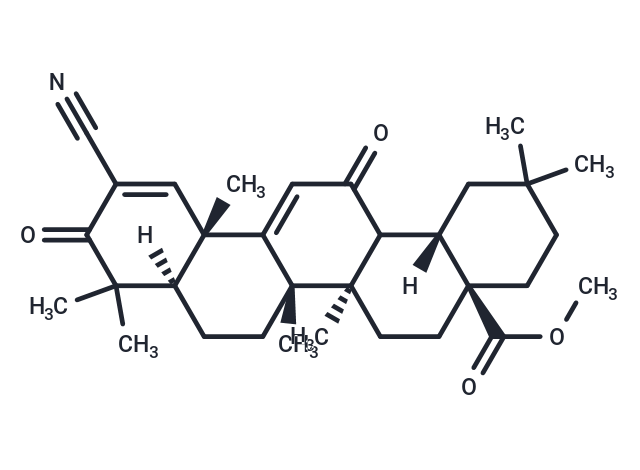Shopping Cart
- Remove All
 Your shopping cart is currently empty
Your shopping cart is currently empty

Bardoxolone Methyl (TP-155) is a synthetic triterpenoid that acts as an activator of the Nrf2 pathway and an inhibitor of the NF-κB pathway with potential anti-tumor and anti-inflammatory activities.

| Pack Size | Price | Availability | Quantity |
|---|---|---|---|
| 10 mg | $39 | In Stock | |
| 25 mg | $59 | In Stock | |
| 50 mg | $80 | In Stock | |
| 100 mg | $122 | In Stock | |
| 200 mg | $197 | In Stock | |
| 500 mg | $447 | In Stock | |
| 1 mL x 10 mM (in DMSO) | $43 | In Stock |
| Description | Bardoxolone Methyl (TP-155) is a synthetic triterpenoid that acts as an activator of the Nrf2 pathway and an inhibitor of the NF-κB pathway with potential anti-tumor and anti-inflammatory activities. |
| In vitro | Bardoxolone Methyl exhibits potent inhibitory activities against production of nitric oxide induced by interferon-? in mouse macrophages with IC50 of 0.1 nM. [1] Bardoxolone Methyl decreases the viability of leukemic HL-60, KG-1, and NB4 cells with IC50 of 0.4, 0.4, and 0.27 μM, respectively. CDDO-Me induces pro-apoptotic Bax protein, inhibits the activation of ERK1/2, and it blocks Bcl-2 phosphorylation, which contributes to the induction of apoptosis. [2] Bardoxolone Methyl potently inhibits both constitutive and inducible NF-kappaB activated by TNF, interleukin (IL)-1beta, phorbol ester, okadaic acid, hydrogen peroxide, lipopolysaccharide, and cigarette smoke. [3] |
| In vivo | Bardoxolone Methyl (60 mg/kg) reduces the number, size, and severity of lung tumors in vivo. [4] Bardoxolone Methyl significantly reduces the in vivo inflammatory cytokine response following LPS challenge, induces HO-1 protein expression in the spleen, and protects mice against lethal-dose LPS. [5] |
| Kinase Assay | IKK assay : To determine the effect of CDDO-Me on TNF-induced IKK activation, IKK is analyzed. Briefly, the IKK complex from whole-cell extracts was precipitated with antibody against IKKα and IKKβ and then treated with protein A/G-Sepharose beads. After 2 hours, the beads are washed with lysis buffer and then resuspended in a kinase assay mixture containing 50 mmol/L HEPES (pH 7.4), 20 mmol/L MgCl2, 2 mmol/L DTT, 20 μCi [γ-32P]ATP, 10 μmol/L unlabeled ATP, and 2 μg of substrate glutathione S-transferase-IκBα (amino acids 1-54). After incubation at 30°C for 30 minutes, the reaction is terminated by boiling with SDS sample buffer for 5 minutes. Finally, the protein is resolved on 10% SDS-PAGE, the gel is dried, and the radioactive bands are visualized with a Storm820. To determine the total amounts of IKK-α and IKK-β in each sample, 50 μg of whole-cell proteins are resolved on 7.5% SDS-PAGE, electrotransferred to a nitrocellulose membrane, and then blotted with either anti-IKK-α or anti-IKK-β antibody. |
| Cell Research | Leukemic cell lines are cultured at a density of 3.0 × 105 cells/mL, and AML mononuclear cells are cultured at 5 × 105 cells/mL in the presence or absence of indicated concentrations of CDDO-Me. Appropriate amounts of DMSO (final concentration less than 0.05%) are included as control. For cytotoxicity studies, 1 μM ara-C is added to the cultures. After 24 to 72 hours, viable cells are counted with the trypan blue dye exclusion method using a hematocytometer. (Only for Reference) |
| Alias | TP-155, RTA 402, NSC 713200, CDDO Methyl ester |
| Molecular Weight | 505.69 |
| Formula | C32H43NO4 |
| Cas No. | 218600-53-4 |
| Smiles | [H][C@@]12CC(C)(C)CC[C@@]1(CC[C@]1(C)C2C(=O)C=C2[C@@]1(C)CC[C@@]1([H])C(C)(C)C(=O)C(=C[C@]21C)C#N)C(=O)OC |
| Relative Density. | 1.15g/cm3 |
| Storage | Powder: -20°C for 3 years | In solvent: -80°C for 1 year | Shipping with blue ice. | |||||||||||||||||||||||||
| Solubility Information | H2O: < 1 mg/mL (insoluble or slightly soluble) DMSO: 18.33 mg/mL (36.25 mM), Sonication is recommended. Ethanol: < 1 mg/mL (insoluble or slightly soluble) | |||||||||||||||||||||||||
Solution Preparation Table | ||||||||||||||||||||||||||
DMSO
| ||||||||||||||||||||||||||

Copyright © 2015-2025 TargetMol Chemicals Inc. All Rights Reserved.